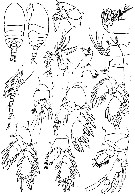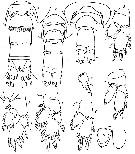|
|
 |
|
Platycopioida ( Order ) |
|
|
|
Platycopiidae ( Family ) |
|
|
|
Platycopia ( Genus ) |
|
|
| |
Platycopia robusta Andronov, 1985 (F,M) | |
| | | | | | | Ref.: | | | Andronov, 1985 (p.1735, figs.F,M, juv.); Vives & Shmeleva, 2010 (p.32, figs.F,M) |  issued from : Andronov V.N. in Zool. Zh., 1973, 64 (11). [p.1736, Fig.1]. Female (from off cap Blanc, Mauritania): 1-2, habitus (dorsal and lateral, respectively); 3, A1; 4, A2; 5, Mx1; 6, Md; 7, Mx2; 8, Mxp; 9-13, P1 to P5. Male: 14, P5.
|
 issued from : Andronov V.N. in Zool. Zh., 1973, 64 (11). [p.1737, Fig.2]. Male: 1, last thoracic segments and urosome (dorsal) Copepodite V female: 2, last thoracic segments and urosome (dorsal); 3, P5; 4, P2 (distal part). Copepodite V Male: 5, P5. Copepodite IV: 6, last thoracic segments and urosome); 7-10, P2 to P5.
|
 Both A1 male nongeniculate. Sexual dimorphism present in P5. A2 exopod 6-segmented. Exopod of Md indistinctly 3-segmented. Mx2 not extremely modified. Syncoxa of Mxp with 2 setae ...... P1 with 2-segmented exopod and 2-segmented endopod. Exopod of P2 to P5 having inner setae; P2-P5 with outer spines on 1st exopod segment..... Platycopia...... 3 - 1st and/or 2nd exopod segments of P2-P5 of female having inner setae or spines.....4 - 2nd exopod segment of P5 male with 2 proximal spines along outer margin...... 5 - 3rd endopod segment of male P5 having 5 spines....... 6 - Distal 2 endopod segments of P3 and P4 incompletely fused; 1st exopod segment of female P5 without inner seta.
| | | | | NZ: | 1 | | |
|
Distribution map of Platycopia robusta by geographical zones
|
| | |  Chart of 1996 Chart of 1996 | |
| | | | Loc: | | | Mauritania (Cap Blanc) | | | | N: | 1 | | | | Lg.: | | | (603) F: 0,71-0,6; M: 0,62-0,54; {F: 0,60-0,71; M: 0,54-0,62} | | | | Rem.: | epibenthic (20 m).
Andronov (1985, p.1738-1739) points to: It has been shown that the abdomens of adult males and females of this and, probally, other species are made up of five and not, as was held earlier, four segments; the first abdominal (genital) segment in a female is separated from the second one; mobile articulation both in a female and in a male is between the first and second abdominal segments (in contradistinction to Gymnoplea and Podoplea). These and some other signs corroborate Lang's opinion (1948) that the family Platycopiidae is a valid suborder of the Copepoda, named Progymnoplea. | | | Last update : 28/01/2015 | |
|
|
 Any use of this site for a publication will be mentioned with the following reference : Any use of this site for a publication will be mentioned with the following reference :
Razouls C., Desreumaux N., Kouwenberg J. and de Bovée F., 2005-2025. - Biodiversity of Marine Planktonic Copepods (morphology, geographical distribution and biological data). Sorbonne University, CNRS. Available at http://copepodes.obs-banyuls.fr/en [Accessed July 11, 2025] © copyright 2005-2025 Sorbonne University, CNRS
|
|
 |
 |





